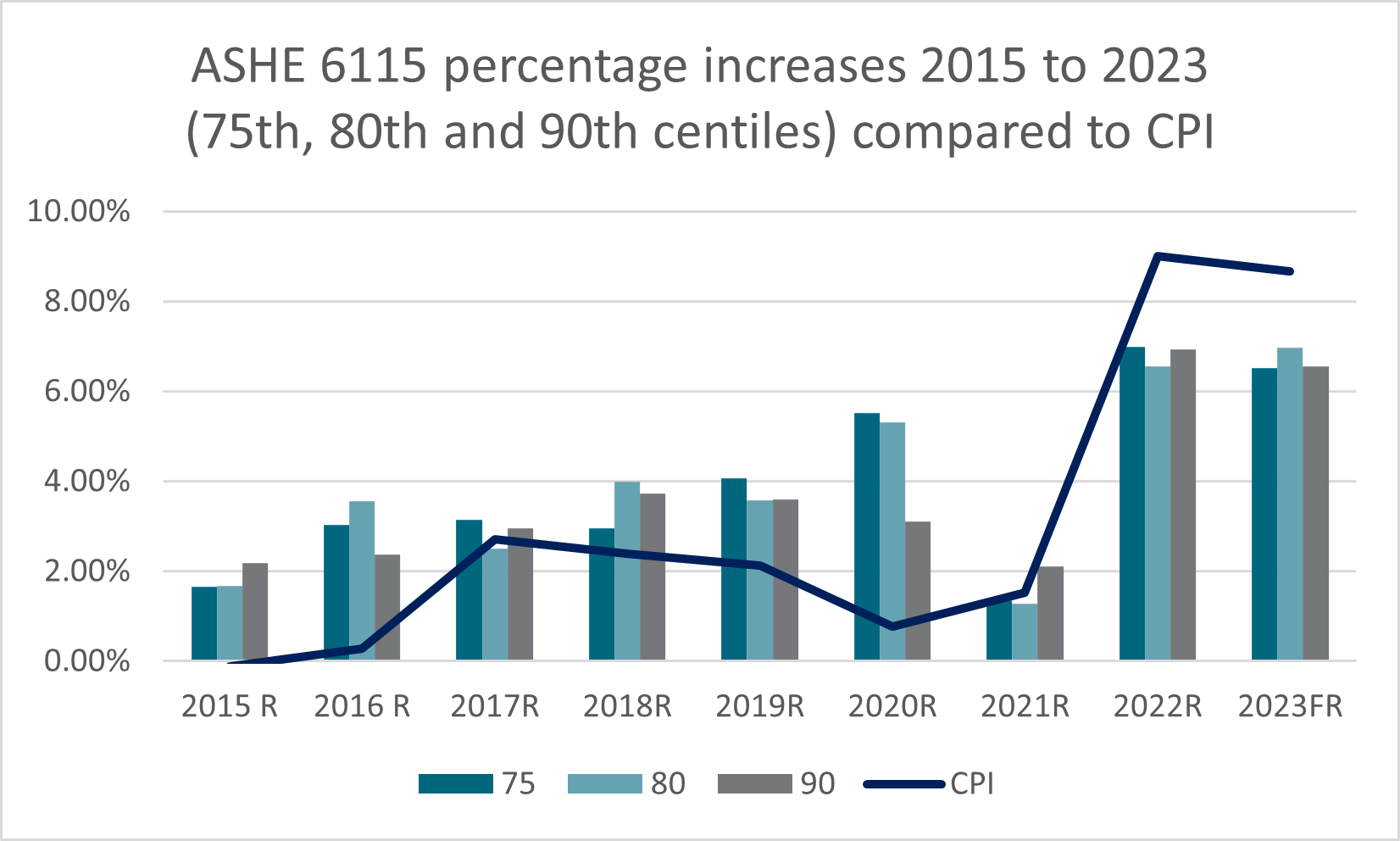ASHE figures for care workers
-
Legal Development 2023年11月3日 2023年11月3日
-
Casualty claims
The provisional figures for the Annual Survey of Hours and Earnings (ASHE) 2023 have now been published together with the final 2022 figures.
The full government release can be found here.
The most recent data shows that full-time carers overall weekly earnings have increased more than full-time earnings in general and CPI, though not as much as RPI.
The overall increases are summarised below, alongside other inflation measures for comparison:
| % Change 2022 to 2023 | % Change 2021 to 2022 | |
|---|---|---|
| Median weekly earnings for full-time employees (all workers) | 6.2% | 5.0% |
| Median weekly earnings for full-time carers | 9.4% | 8.4% |
| National Living Wage (for those age 23 and over) | 9.7% | 6.6% |
| Retail Prices Index (RPI) | 11.4% | 11.1% |
| Consumer Prices Index (CPI) | 8.7% | 9.0% |
The 6.2% increase in the median weekly earnings for all workers is the highest growth since comparable records began in 1997. Growth was seen across all major occupational groups, particularly for lower-paying occupations including caring, leisure and other service occupations of 9.4% outstripping CPI inflation over the same period [1].
This is driven, at least in part, by the above CPI increase in the National Living Wage (NLW) reflecting efforts to combat inflation and the cost-of-living crisis when the latest level of NLW was set. The target is for the NLW to reach two thirds of median hourly pay by October 2024 with an estimate of £11.16 [2], suggesting the NLW increase next year will be lower at around 7.1%. The rate of increase for full-time carers may therefore also reduce but nothing is certain.
Care workers
Since the 2010 reclassification, the ONS have continued to publish figures equivalent to ASHE 6115 (care assistants and home carers) in Table 26 to assist with the indexation of periodical payment orders for care costs which have now been reclassified under SOC 2020 as follows:
SOC 2010 – combining ASHE 6145 (care workers & home carers) and 6146 (senior care workers)
SOC 2020 – combining ASHE 6135 (care workers & home carers) and 6136 (senior care workers)
The Revised 2021 ASHE figures published in November 2022 were the first figures produced under the SOC 2020 classification as discussed here.
It is the ASHE 6115 gross hourly earnings (Table 26.5a) which are applicable to periodical payment orders.
The full Table 26.5a can be found here and the overall increases in the median hourly rates are shown below:
| % Change 2022 to 2023 | % Change 2021 to 2022 | |
|---|---|---|
| Median hourly earnings for full-time employees (all workers) | 6.59% | 4.67% |
| Median hourly earnings for full-time carers | 8.14% | 8.63% |
| Median hourly earnings for all employees (all workers) | 7.37% | 4.60% |
| Median hourly earnings for all carers | 7.99% | 7.62% |
Whilst there were large increases in the median hourly earnings for all workers and all full-time workers to 2023 compared to 2022, this was not replicated in terms of all carers (which rose slightly) and full-time carers (which fell slightly). The rate of increases for carers continues to exceed those for the comparable category (all or full-time) of workers.
The increase in median hourly earnings for carers is less than the increase in CPI indicating that there are other factors (such as an increase in the number of hours worked) affecting the level of median weekly earnings for carers in addition to an uplift in hourly rates leading to the increase in median weekly earnings exceeding the CPI increase as seen above.
Many people say the care sector continues to be badly affected by recruitment and retention issues following Brexit and the Covid pandemic which, together with the current cost of living crisis, will exacerbate the conflicting interests of carers wanting higher wages and cost pressures on those hiring carers.
Application to AHSE Linked PPOs
The figures for the most common percentiles in terms of Periodical Payment orders are shown below for the hourly earnings for all carers:
| Tables 26.5a | 2022 Provisional | 2022 Revised | 2023 Provisional | % Change 2022 to 2023 | % Change 2021 to 2022 |
|---|---|---|---|---|---|
| SOC 2020 | SOC 2020 | SOC 2020 | |||
| 90th centile | £15.54 | £15.57 | £16.59 | 6.55% | 6.73% |
| 80th centile | £13.49 | £13.49 | £14.43 | 6.97% | 6.56% |
| 75th centile | £12.87 | £12.87 | £13.71 | 6.53% | 6.98% |
While the rate of increase for the 80th centile has increased, it has fallen for the 75th and 90th centiles.
The chart below illustrates the movement in the annual percentage increases in ASHE 6115 75th, 80th and 90th centiles hourly rates [3] alongside the corresponding percentage increases for CPI. After a period of above CPI increases in 2018 to 2020, the increases in 2022 and 2023 are once again below CPI.

Should you require any further information, or assistance in calculating the periodical payments on, please do not hesitate to contact Kate Mikolajewski, Jodie McAuley or Heather Dale.
[1] Source: Office for National Statistics (ONS), released 1 November 2023, ONS website, statistical bulletin, Employee earnings in the UK: 2023
[2] Source: The Low Pay Commission ‘The National Minimum Wage in 2023 and forecast National Living Wages in 2024’ The National Minimum Wage in 2023 (publishing.service.gov.uk)
[3] Although there is effectively a ‘break’ in the data at each SOC reclassification which means direct comparison across SOC 2000, SOC 2010 and SOC 2020 may not be possible, we have used the data to illustrate general trends
结束
